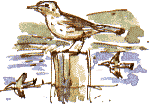|   There
are no fewer than six footballs (and one motorcycle helmet) amongst the
flotsam in the Calder today. I imagine a big tree, like a baobab, somewhere
upstream near Dewsbury with branches overhanging the river, dropping its
football fruits which drift with the current like coconuts to wash up
on some distant shore: Horbury Bridge. There
are no fewer than six footballs (and one motorcycle helmet) amongst the
flotsam in the Calder today. I imagine a big tree, like a baobab, somewhere
upstream near Dewsbury with branches overhanging the river, dropping its
football fruits which drift with the current like coconuts to wash up
on some distant shore: Horbury Bridge.
 In
the deep gully that Coxley Beck takes before it plunges through a tunnel
to the river a grey wagtail perches on a piece of white
boarding, which looks like a stray piece of pack ice amongst the twiggy
debris. In
the deep gully that Coxley Beck takes before it plunges through a tunnel
to the river a grey wagtail perches on a piece of white
boarding, which looks like a stray piece of pack ice amongst the twiggy
debris.
Hips and Haws

Rose hips

Redwing
|
On some hedges there is nothing on
the bare branches but hips and haws. I have an e-mail asking what
the phrase 'hips and haws' means:
As far as I know haws refers only to the fruit
of the hawthorn. As they're ripe at the same time
as rose hips it's natural to lump the two together. Hawthorn is
in the Rosaceae, the same family as the rose, but I don't think
I've ever heard of any fruit associated with wild or cultivated
roses being referred to as a haw.
I think it's the kind of pairing that slips off the tongue, like
oranges and lemons, cats and dogs or slugs and snails.
Were haws ever eaten? They're woody, but the fieldfares
and redwings, winter visitors from Scandinavia
and elsewhere, feast on them so there's evidently nutrition in them.
It's been quite a good year for haws.
During the war, children collected rose hips by the sack load for
rose hip syrup, a vitamin C supplement in the days of rationing
(and still available in the 1970s) but I've never heard of anyone
collecting hawthorn berries.
|

Haws

Fieldfare
|
I remember 'itching powder' being referred to in children's comics. It
was a practical joke product consisting of the prickly seeds found inside
rose hips. Barbara tells me that the boys at her junior school sometimes
had packets of the stuff and on one occasion they put some down her neck.
From her description it sounds as if it consisted of dried rose hips seeds.

Related Links
 Looking
up 'ice floe' I found these two sites that are poles apart: Looking
up 'ice floe' I found these two sites that are poles apart:
North Pole Web Cam:
the North Pole is in Winter darkness from October to March the last clear
image before winter darkness (left) was taken at 21.34 on Sunday,
19th September. Even then the internal temperature at camera 1 was down
to -9.5°centigrade.
 South
Pole Web Cam (right) from the roof of the Atmospheric Research
Observatory. South
Pole Web Cam (right) from the roof of the Atmospheric Research
Observatory.
Both are NOAA (National Oceanic and
Atmospheric Administration) web sites.
Picking Rosehips
and the Rosehip Syrup Factory 1956 from the BBC Nation on Film archive.
Richard Bell, richard@willowisland.co.uk |
![]()